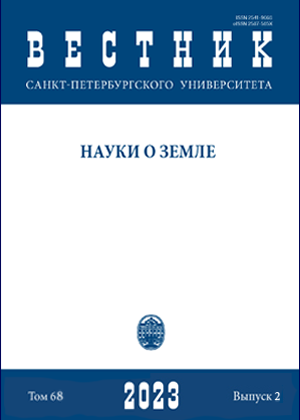Composition and formation conditions of noble metal ores of the Koykar-Svyatnavolok sill (Republic of Karelia)
DOI:
https://doi.org/10.21638/spbu07.2023.203Abstract
The Viksha iron ore deposit is confined to the Koykarsko-Sviatnavolok sill, where as a part of ore bodies, in addition to the main components - iron and titanium, it contains gold, platinum, and palladium. The purpose of this publication is to determine the type and patterns of noble metal mineralization in gabbro-dolerites of the Koykar-Svyatnavolok sill, to consider the mechanisms of accumulation and localization of precious metals in ore bodies. The repeated occurrence in the section of the intrusion of an association of two rock varieties of contrasting composition (high-iron - titanomagnetite gabbro-dolerites, and high-siliceous - granophyres), as well as the revealed petrographic, petrochemical and geochemical regularities, allow us to consider liquid stratification of magmatic melt as a mechanism for the formation of ore titanomagnetite horizons ( segregation). This liquid immiscibility led to the accumulation of noble metals in the high-iron fluidized liquate in accordance with distribution coefficients of nobel metals between silicate and oxide melts and between melt and fluid. The confinement of noble metal mineralization to sulfide, cobaltite-bornite-chalcopyrite accumulations in ore titanomagnetite horizons has been established, which corresponds to the low-sulfide noble metal type of mineralization. Precious metal mineralization is represented by both native mineral forms (arsenides, sulfoarsenides, antimonides and intermetallides of platinum group metals, gold and silver tellurides, electrum, native gold) and isomorphic impurities in bornite and cobaltite. The relationship between the formation of minerals bearing noble metals and the process of chloritization against the background of the transformation of protolith titanomagnetite is shown. A model for the concentration of precious metals from basaltoid melt in several stages is proposed: enrichment of fluidized high-iron ore liquat with precious metals; their accumulation in the residual fluid and in the sulfide liquid during the crystallization of ore liquat; their partial entry into the hydrothermal solution during fluid cooling and hydrothermal metasomatism of earlier crystals. The localization of noble metals occurred as the residual fluid cooled, due to the destruction of complex chloride and sulfide compounds with noble and non-ferrous metals and the crystallization of sulfide-precious metal paragenesis within the ore horizons.
Keywords:
iron ore gabbro-dolerites, Viksha deposit, low sulfide noble metal type of mineralization, model of concentration and localization of noble metals
Downloads
References
Downloads
Published
How to Cite
Issue
Section
License
Articles of "Vestnik of Saint Petersburg University. Earth Sciences" are open access distributed under the terms of the License Agreement with Saint Petersburg State University, which permits to the authors unrestricted distribution and self-archiving free of charge.






